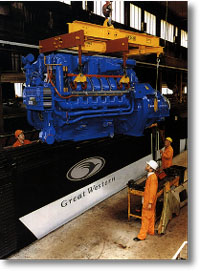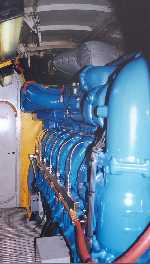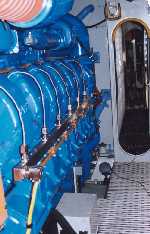
|
||||||||
| Paxman 12VP185 being installed in a Great Western HST |
Some of the Paxman Valenta engines, although relatively reliable overall, were showing signs of aging by the mid 1990s. Various options were considered, including replacing the engines with new Valentas, replacing them with another Paxman engine, or replacing them with another type of engine.
A decision was made in 1999 to replace them with Paxman 12VP185 engines which had been trialled in HSTs in the UK. Twelve class 43 HST locos had been retrofitted with the VP185, starting with 43170 in September 1994.

|
||||||||
| Paxman 12VP185 being installed in a Great Western HST |
Tenders were called for the supply and installation of new engines. Alstom, then the owner of Paxman, unsuccessfully tendered to fit its own engines. The contract was awarded to A. Goninan & Co of Newcastle, who had rebuilt the trailer cars inthe early 1990s.
XP2016, also in need of other major work, was shopped in April 2000 and XP2006 soon after.

|

|
|||||||
| View from the free end | View from the Generator end |
Peter Clark wrote of his visit to Newcastle to watch a static test of a VP185.
This was a retrofit, replacing a 12RP200L Valenta engine in a very space-constrained application. The existing cooling system had hydraulic leaks in the cooling fan drive, and load box testing had not commenced while we were there.
One particular complication resulting from this retrofit was the complex ducting from the existing dust filtration system (in the next compartment forward) to the four low pressure turbochargers. The previous Valenta engine had a single turbocharger. This is unlikely to be a problem on a new installation, nor in a marine installation. However, the four low pressure turbochargers, two high pressure turbochargers, and associated intercooler and aftercooler are all readily accessible.
The engine was run on very light load on an auxiliary alternator up to 1500 rpm while I was in the engine room (with ear plugs!). I was impressed by the smooth start (the engine was still warm) and the apparent lack of vibration. It was not possible to determine the noise level, however.
Even at 1500 rpm, I was impressed by the smooth operation of the engine. I tried to balance a 50 cent piece on edge on the engine and failed, but [an Alstom engineer] took it and placed it on a machined flat near the turbocharger box. A very low amplitude, high frequency vibration caused the coin to spin on its edge, but it did not fall over. I was very impressed!
We were shown the new Regulatuers Europa "Viking" control equipment and monitoring system, which provides a remote display of engine condition through a cellular phone link. This system is integrated with a GPS system, using an antenna toward the rear of the vehicle. A display was provided on the screen of a laptop computer plugged into the control unit in the rear compartment of the vehicle.
It was pointed out that the system had automatically determined that Broadmeadow was the nearest railway station, allowing the user at the remote monitoring station know where the engine was at any given time, as well as its speed, temperatures and pressures.
While it is difficult to judge from a limited exposure to a single engine, the 12VP185 seems to meet the expectations of the designers, and in the installation concerned, appears to be easily inspected and maintained.
|
VP185 sales bruchure 630kb PDF |

XP2016 returned to service on 27th June 2000. It was test run on the Central West XPT to Dubbo for several days, then made its first long distance run to Murwillumbah on 4th July 2000.
XP2006, the second to receive a VP185, returned to Sydney on Friday 14th
July 2000 and worked the Central West XPT over the weekend.
The State Rail Authority of New South Wales has initiated a program to replace its Paxman 12RP200L (Valenta) Engines that power the XPT Power Cars with Paxman 12VP185L engines. This has resulted in the redundancy of the existing Paxman 12RP200L (Valenta) Engines. The proposed contract is for the removal from two sites, Newcastle and Sydenham a total quantity of 23 Paxman 12RP200L (Valenta) Engines including a quantity of spare parts and tools. It must be noted that not all engines, spare parts and tools are immediately available for disposal as the engine replacement program extends until 2002.The tender document (PDF, 87kb) has been preserved here. It contains some interesting details about the history of the engines, hours run and photos of them lined up in Newcastle.The Contractor is required to remove the nominated equipment in accordance with the nominated program contained in this Specification. Part offers may be considered.